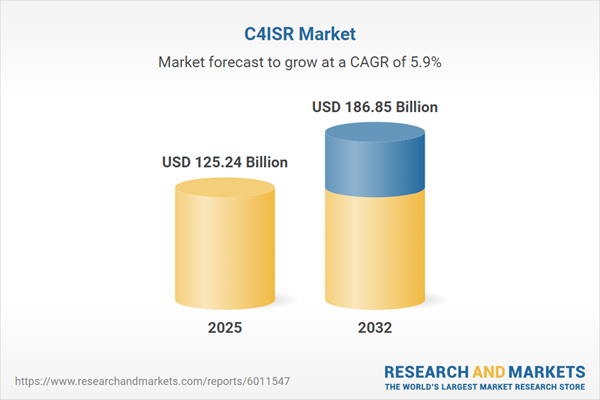Speak directly to the analyst to clarify any post sales queries you may have.
The C4ISR market is evolving rapidly as organizations face greater operational complexity and prioritize digital transformation, operational resilience, and cohesive intelligence strategies. Senior leaders must adopt agile approaches to integrate command, control, communications, intelligence, surveillance, and reconnaissance capabilities for strategic advantage.
Market Snapshot: Strategic Growth and Future Outlook of the C4ISR Market
The global C4ISR market is anticipated to expand steadily, shaped by the increasing demand for secure digital infrastructure and advanced intelligence solutions across defense and commercial landscapes. Modernization programs are propelling the market from a valuation of USD 118.40 billion in 2024 to USD 125.24 billion by 2025, with a projected total of USD 186.85 billion by 2032. This growth represents a compound annual growth rate (CAGR) of 5.86 percent, driven by ongoing capability development, strategic technology partnerships, and shifting regulatory frameworks that influence market strategies on a global scale.
Scope & Segmentation: Executive Guide to Global C4ISR
This executive-focused report provides a clear framework for senior decision-makers seeking market intelligence to support critical investments and strategic initiatives. Its scope covers comprehensive segment analysis:
- Platform Types: Addresses the unique demands of airborne, land, and naval platforms, aligning with multi-domain operational goals and varied mission environments.
- Component Categories: Hardware is centered on securing communication channels and supporting robust infrastructure. Software offers high-performance analytics, while service elements cover consulting, integration, and complete lifecycle management for effective operations.
- Solution Sets: Integrated platforms are designed to optimize workflows in command, control, intelligence, surveillance, and reconnaissance, thereby increasing efficiency and adaptation capability in challenging operational conditions.
- End Users: Defense agencies, homeland security organizations, and private sector entities depend on scalable architectures to meet diverse mission and operational requirements.
- Regional Dynamics: The Americas, Europe, Middle East and Africa, and Asia-Pacific each present distinct modernization strategies, regulatory influences, and trends in technology adoption that shape investment decisions and competitive positioning.
- Company Analysis: Profiles leading organizations including Lockheed Martin, Raytheon Technologies, Northrop Grumman, BAE Systems, General Dynamics, Thales, Leonardo, L3Harris, Airbus, and Elbit Systems. These firms are evaluated for their approaches to innovation and adaptability within an evolving technology landscape.
C4ISR Market: Key Takeaways for Senior Decision-Makers
- Unmanned system integration and artificial intelligence adoption are enabling organizations to address complex operational environments and support rapid, actionable decision-making.
- Open-standard and modular architectures are facilitating smoother integration processes and providing a clear route for future technology upgrades, supporting the ongoing relevance of these systems.
- Flexible procurement strategies and collaborative contracting are becoming essential tools, allowing organizations to adapt quickly to emerging threats and shifting mission needs without operational disruption.
- Advanced supply chain management approaches, leveraging technologies such as additive manufacturing, are helping to reduce vulnerabilities and maintain operational reliability under unpredictable conditions.
- Digital twin and simulation technologies are being used to improve scenario planning and enhance team readiness, fostering agility in fast-changing operational contexts.
- The capacity for rapid deployment and dynamic allocation of resources is supporting mission continuity, even as organizational priorities evolve in response to shifting global challenges.
Tariff Impact: Navigating Global Trade and Procurement
Recent adjustments to U.S. trade tariffs have prompted many C4ISR organizations to review and adapt their procurement and supply chain strategies. Senior leaders are emphasizing nearshoring, diversification of supplier networks, and the application of additive manufacturing to secure consistent access to essential components and maintain contractual performance. These strategic shifts are reinforced by the application of advanced analytics and scenario-based planning, supporting stable operations in a changing defense trade environment.
Methodology & Data Sources
This report utilizes a rigorous methodology, drawing from executive interviews, analysis of technical documentation, and procurement data reviews. Supplementary expert surveys and workshops contribute additional insights, ensuring that the intelligence delivered is relevant, practical, and tailored to the needs of leaders operating within the C4ISR ecosystem.
Why This Report Matters
- Enables senior decision-makers to anticipate market and technology shifts, ensuring timely, risk-aware investments aligned with changes in the C4ISR sector.
- Offers benchmarking intelligence to support regional and strategic comparison, helping leaders identify optimal investment strategies based on evolving trends.
- Delivers actionable insights into emerging challenges and opportunities, facilitating secure implementation of integrated intelligence systems that address changing operational demands.
Conclusion
Current C4ISR market intelligence empowers executives to manage technology integration, support agile operations, and strengthen their position in an increasingly dynamic global security environment.
Additional Product Information:
- Purchase of this report includes 1 year online access with quarterly updates.
- This report can be updated on request. Please contact our Customer Experience team using the Ask a Question widget on our website.
Table of Contents
3. Executive Summary
4. Market Overview
7. Cumulative Impact of Artificial Intelligence 2025
Companies Mentioned
The companies profiled in this C4ISR market report include:- Lockheed Martin Corporation
- Raytheon Technologies Corporation
- Northrop Grumman Corporation
- BAE Systems plc
- General Dynamics Corporation
- Thales S.A.
- Leonardo S.p.A.
- L3Harris Technologies, Inc.
- Airbus SE
- Elbit Systems Ltd.
Table Information
| Report Attribute | Details |
|---|---|
| No. of Pages | 199 |
| Published | October 2025 |
| Forecast Period | 2025 - 2032 |
| Estimated Market Value ( USD | $ 125.24 Billion |
| Forecasted Market Value ( USD | $ 186.85 Billion |
| Compound Annual Growth Rate | 5.8% |
| Regions Covered | Global |
| No. of Companies Mentioned | 11 |









